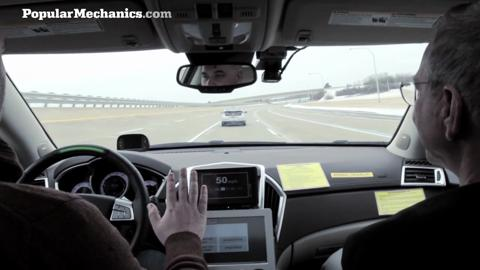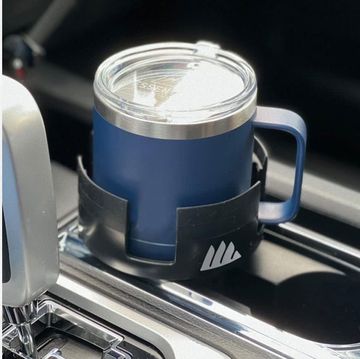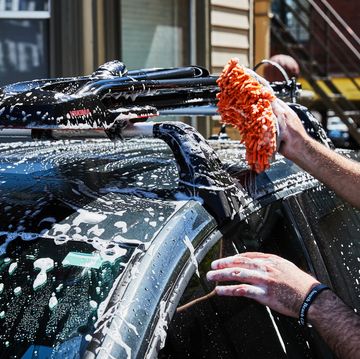The self-driving car is coming—that much is certain. But the future isn't as clear-cut as "your next car will drive itself." We wade into the messy issues, including how this all works, how good robot drivers really are, and whether we humans will even be allowed to drive in the automated automotive future.
1. When can I let go of the wheel?
As soon as I hit the small black lane-centering button, I can feel the wheel stiffen in my hands. Suddenly the light bar atop it begins glowing a soft green, signaling that the car has taken over the task of steering. I had already surrendered control of the acceleration and braking to the vehicle's adaptive cruise control, and now with my feet flat on the floor, I slowly unwrap my fingers and release the wheel. Sitting in the passenger seat is Jeremy Salinger, who works on General Motors' semiautonomous car program. He's seen the car do this dozens, possibly hundreds, of times, but, if only to reassure me, he states the obvious: "The car is in control now."
My remaining sense of caution keeps my hands nervously hovering above the wheel for a few seconds as our 2012 Cadillac SRX test vehicle hurtles forward at 60 mph, effortlessly bending into one of the sweeping turns of the oval track at GM's Milford Proving Grounds in Michigan. In the rear of the heavily modified SUV, an onboard computer collects data from an array of cameras and sensors to electronically read the road and determine the vehicle's position. Using this information, the car controls the electrically assisted steering to keep the car perfectly centered in the lane.
"Let's do something, like a lane change," Salinger says. The light bar switches from green to blue as I grab hold of the wheel and signal right, indicating that I'm overriding the system. Once we are settled into the new lane, the light bar changes back to green and I let go of the wheel. We repeat the exercise, returning to the center lane of the five-lane track, and then my hands drop down to rest on my legs. Now fully at ease, I watch the wheel periodically turn and straighten as we speed around the track. The sight is both mesmerizing and unsettlingas if a ghost were driving. But this is no spooky apparition, this is GM's Super Cruise technology, and it could be available in a production vehicle within five years.
2. Wait, how soon is this happening?
Very soon. Although GM hasn't confirmed a hard date for deployment of the system, it hopes to have Super Cruise as an option by the end of the decade, possibly as soon as the 2017 or 2018 model year. Super Cruise is part of a trend that has sneaked up on the car-buying public. The active safety systems in many modern production carsforward-collision warning, park assist, adaptive cruise control, blind-spot monitoring, and othersare inching the vehicles we buy toward autonomy. By using a combination of sensors, radar, GPS, and cameras, these systems enable a car to interpret its surroundings and issue warnings or even brake the car if a collision with another vehicle or a pedestrian is imminent. As these systems become connected, our cars become smarter.
Technologically, GM's Super Cruise is similar to driver- assistance systems provided by Mercedes-Benz and other carmakers. But these other systems also require that the driver periodically touch the wheel to ensure he or she remains engaged in the driving experience. Where Super Cruise differs is that for the first time GM aims to allow the driver to completely let go of the wheel for extended periods of time. Functionally, this change is revolutionary. By fully taking over the task of highway driving, Super Cruise might represent the most important shift in the drivercar relationship in automotive history.
3. So, my next car will drive itself?
Not so fast. First off, let's get some semantics out of the way. The Super Cruiseequipped SRX I rode in is a self-driving car, but it can't do everything on its own. Super Cruise will only be available under select highway conditions and will have speed and turning limitations, so think of it more like autopilot for your car. By definition, this makes it semiautonomous (though much more capable, Google's self- driving cars are also semiautonomous). A fully autonomous production carwhere you plug your destination into the GPS and settle in for a 2-hour movieis still a long way off, but the technology is advancing fast. Recently Audi and Volvo demonstrated vehicles that can park themselves; Volvo says this feature could be available as early as 2014.
Still, systems such as Super Cruise challenge conventional notions of who or what is doing the driving, and this makes carmakers and regulators nervous. "I think the one thing we will always want to maintain, and the manufacturers will likely tell you the same thing, is that the driver's still responsible for the driving task," David Strickland, administrator of the National Highway Traffic Safety Administration, says. "That will never change."
4. How does the car see the road?
Super Cruise and other similar systems do more than just see the road. Using an array of sensors, lasers, radar, cameras, and GPS technology, they can actually analyze a car's surroundings.
Super Cruise is a combination of two technologies. The first is the increasingly common adaptive cruise control, which uses a long-range radar (more than 100 meters) in the grille to keep the car a uniform distance behind another vehicle while maintaining a set speed. The second, lane- centering, uses multiple cameras with machine-vision software to read road lines and detect objects. This information is sent to a computer that processes the data and adjusts the electrically assisted steering to keep the vehicle centered in the lane. Because Super Cruise is intended only for highways, GM will use the vehicle's GPS to determine its location before allowing the driver to engage the feature. In addition, GM is also considering using short-range radars (30 to 50 meters) and extra ultrasonic sensors (3 meters) to enhance the vehicle's overall awareness. Cars with park-assist systems already have four similar sensors in the front and in the rear of the car. GM is also experimenting with cost-effective LIDAR units, which use lasers instead of sound and are more powerful and accurate than ultrasonic sensors. It's unclear whether LIDAR will make it into the same vehicle as Super Cruise.
5. Are these autonomous (sorry, semi-autonomous) cars decent drivers?
Sure are. According to Nady Boules, a director within GM's R&D, semiautonomous cars perform better than human drivers in many respects. Unlike people, they can continuously monitor all sides of the vehicle, can react almost instantaneously, and are impervious to distraction. They're also more efficient drivers. One recent paper presented at an Institute of Electrical and Electronics Engineers conference estimated that a fleet of cars with sensors could increase highway capacity by 43 percent. If the cars could also communicate with one another, that number jumps to an incredible 273 percent.
The NHTSA and several carmakers are already testing vehicles that can talk to each other. I got a chance to stop by GM's technical center in Warren, Mich., for a demonstration of this vehicle-to-vehicle (V2V) communication. In a large parking lot GM engineers had me run through a series of exercises with two cars, each equipped with GPS and a small Wi-Fi transponder. Using the GPS to determine its location and the transponder to talk with the other vehicle, my car warned me when the other vehicle braked hard in front of me, was in my blind spot, or was approaching from around a corner that had an obstructed view. Unlike with radar and cameras, line of sight isn't required for V2V communication, and the transponders are relatively inexpensive compared with the hardware required for most active safety systems. On its own, V2V technology is compelling, but once it is connected to the other active safety systems in a vehicle, it has powerful potential.
6. Is any of this even legal?
It is, but that's mostly because laws regulating self-driving cars didn't exist until recently. Currently legislation is being considered on a state-by-state basis, with Nevada, California, and Florida having passed laws for the testing of self-driving cars on public roads; Michigan is expected to follow. Generally these laws simply stipulate that someone must be in the car and be able to take control of the car in case of an emergency. In May the NHTSA released a set of suggested guidelines for the development of semiautonomous vehicles, but there are still no official federal regulations.
Bryant Walker Smith is a fellow at the Center for Internet and Society at Stanford Law School and the Center for Automotive Research. He points out that along with creating new laws, we will also need to review our existing laws as semiautonomous systems proliferate. "New York state, for example, requires drivers to keep one hand on the wheel at all times," Smith says. "Figure how that reconciles with Super Cruise." He goes on: "Regardless of what the traffic codes, what the vehicle codes specifically say, when a crash happens, how will judges and juries decide what behavior was negligent? So even if you're in a state that doesn't expressly say you have to have your hands on the wheel, will not having your hands on the wheel, will not paying attention, be considered negligent?"
This is a big issue and one that the NHTSA and carmakers are tiptoeing around by insisting that the driver will be responsible at all times. Nevertheless, semiautonomous technologies have huge implications for insurance agencies. Loretta L. Worters is the vice president of communications for the Insurance Information Institute. According to her, systems that improve safety are welcomed by the insurance industry, but as our cars turn into semiautonomous vehicles, we are entering new territory. "For example, it would also likely increase the potential liability of the manufacturer and maintenance/repair business if an accident could be traced to a design or maintenance failure," Worters says.
7. How safe is all this?
Considering that semiautonomous cars rely on a network of active safety systems to work, they're pretty safe. The Insurance Institute for Highway Safety has found that we are already seeing the benefits of systems such as forward-collision warning in the reduction of accidents. That said, they're not 100 percent fail-proof. Chris Urmson leads Google's self-driving car program and is an adjunct professor at Carnegie Mellon University, where he also worked on DARPA's autonomous car challenges. Although Google's test fleet has logged more than 500,000 miles without a major mishap, Urmson admits that the technology will never be flawless. "I think we can make vehicles that are better than human-driven vehicles, but something that won't fail is just an impossibility," he says.
Aside from the possibility of a system failure, semiautonomous technologies also have general limitations. My Super Cruise experience was actually my second attempt at seeing the system in action. On my first trip to the proving grounds, a snowstorm thwarted my mission. The SRX's cameras were unable to read the lines on the snow-covered track, leaving Super Cruise ineffective. That's no small hindrance.
8. No napping behind the wheel, then?
Nope. No matter how capable the vehicle might be, a semiautonomous car cannot be left unattended. And the chance of someone falling asleep is a serious concern for carmakers. Eric Raphael also works on Super Cruise and gave me a technical walk-around of the modified SRX on my visit. "We can't let someone crawl in the back seat and take a nap, but we know they might try that," Raphael says. To prevent a driver from spacing out or worse, GM has developed a monitoring system that will use audial, visual, and possibly haptic feedback to prompt the driver to take over if it detects an emergency or that the driver is too distracted. For example, the light bar at the top of the steering wheel turns bright red when the driver needs to take control of the car.
Of course, at 60 mph and in the middle of heavy traffic, the system can't physically force the driver to reengageand that's more than a little worrisome. Bryan Reimer is a research scientist at MIT's AgeLab and the associate director of the New England University Transportation Center. "Man, who's saying you're going to be awake when you actually need to put your hands back on there?" Reimer says. "All the literature in psychology tells us that we are terrible overseers of highly autonomous systems. We fall asleep. We get bored. We're inattentive.
9. What will driving be like in the future?
Semiautonomous cars and vehicle-to-vehicle communication could profoundly change how traffic flows and even highway design. Here are three likely scenarios.
Near-Term
Once enough cars on the road are able to drive themselves, the first major change we will probably see is an HOV-style self-driving lane on highways. Just enter the lane, set your vehicle to the recommended speed, then leave your monotonous 3-hour haul to the car.
Midterm
As semiautonomous vehicles advance, expect them to start communicating with one another and eventually even with infrastructure. At intersections, smart stoplights could automatically turn to green if no other cars were approachingwhich would smooth out traffic flow, reduce idling, and decrease accidents.
Long-Term
When the majority of the vehicles on the road are semiautonomous and also able to talk with one another, high-speed motoring (we're talking triple digits here), formation driving, and seamless merging could be possible.
10. Can the car avoid something in the road?
Most forward-collision warning systems today can identify another car, a pedestrian, an animal, or a bike, and some can even activate the brakes in low-speed to midspeed situations. But as for avoiding an obstacle, no system out there does that yet. Salinger says cars in the future could have this ability, though it's not something GM is currently developing. Even the possibility raises an important issue: If a split- second steering decision needs to be made, would you want to leave this up to your car? Say the decision comes down to hitting a child in the road or swerving and potentially hitting a telephone pole. Would the car put passengers in danger in order to avoid hitting the kid? A technological issue swiftly becomes a moral one.
11. Will people become worse drivers? Is that even possible?
Generally speaking, the more we use autonomous systems, the more we come to rely on them. So it stands to reason that the less we drive, the rustier we'll get at it. Citing examples such as the pilot error responsible for the crash of Air France 447, MIT's Reimer stresses the need for caution as we integrate these technologies into our cars: "If we look at other domains, and I think the aviation world is a great example of this, it is now a well-accepted fact that autopilot is decreasing pilot skill."
12. What if I want to drive?
The most important question of all. As long as there is a traditional steering wheel in your car, you'll be able to drive. Now, things will get interesting if these semiautonomous systems become so safe and reliable that a human driving is actually viewed as irresponsible by insurers. That won't happen any time soon, but eventually it could.
In one exercise during my Super Cruise demonstration, a Chevy Volt darted in front of our SRX as the car was driving itself. Still traveling at 60 mph, the SRX immediately braked, adjusted its speed to maintain a safe distance behind the Volt, and slightly shifted the wheel to stay centered in the lane. In a situation where a person might overreact and jerk the wheel, causing the car to careen into another vehicle or off the road, I didn't do a thing. I just sat there. I don't think I even flinched. I love driving, but who wouldn't want that as an option in their next car?














